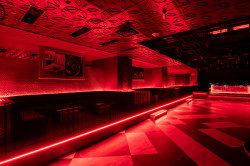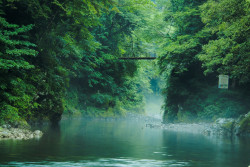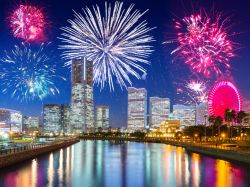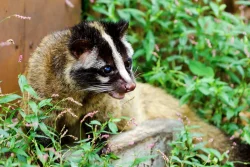
June 19, 2009
Exploring Izu’s Interior
Head inland, and the peninsula is full of surprises
By Metropolis
Originally published on metropolis.co.jp on June 2009

Photos Courtesy of Kawazu Tourist Association
As daytrip destinations go, the Izu Peninsula—a two-hour train ride from Tokyo’s overwhelming bustle—isn’t exactly unexplored territory. Coastal routes are often clogged with admirers of the region’s striking scenery, and seaside towns draw visitors in droves with their combination of surf, sand and delectable seafood. Yet for those who care to step away from the well-trampled byways, Izu’s interior offers up a host of natural delights.
The town of Shuzenji, at the northern end of the peninsula, is a good place to start your exploration. Noted for providing both sanctuary and imprisonment to family members of the Kamakura shogunate in the early 13th century, it is now renowned as an upscale onsen escape. Ryokan line the town’s bubbling stream, and high rollers can splash out on rooms with private baths overlooking the tranquil waterway.
 For a relaxing experience that’s a little lighter on the wallet, be sure to dip your feet in the free public footbath, located on a rock in the middle of the river. It was here that Kobo Daishi, renowned religious authority and founder of the nearby Shuzenji temple, struck the riverbed with his walking stick to bring forth the town’s famed hot waters. With feet refreshed, consider a stroll through the riverside bamboo grove. Attractive red bridges and the occasional tea shop can be glimpsed through the delicate branches, and paper umbrellas along the path invoke sentiments of a bygone era.
For a relaxing experience that’s a little lighter on the wallet, be sure to dip your feet in the free public footbath, located on a rock in the middle of the river. It was here that Kobo Daishi, renowned religious authority and founder of the nearby Shuzenji temple, struck the riverbed with his walking stick to bring forth the town’s famed hot waters. With feet refreshed, consider a stroll through the riverside bamboo grove. Attractive red bridges and the occasional tea shop can be glimpsed through the delicate branches, and paper umbrellas along the path invoke sentiments of a bygone era.
Whether traveling by public transport or with your own set of wheels, the road to follow from here is Route 414. This narrow byway snakes its way down the spine of the peninsula, weaving through scenic tracts of bamboo-carpeted countryside. Occasionally, sprawling fields of iridescent wasabi plants—one of the peninsula’s main crops—punctuate the wooded landscape. In late winter, thanks to a comparatively mild microclimate, Izu welcomes some of Japan’s first cherry blossoms.

Upper Falls at Kawazu
Tucked away in a valley along this route, the seven waterfalls of Kawazu rank as one of the interior’s top sights. A series of cascades, ranging in height from 2-30m, thunder their way through lush canyons. This natural spectacle has long been a draw for poets and dreamers, and Nobel Prize-winning author Yasunari Kawabata chose the falls as the setting for his beloved tale “The Izu Dancer.” Today, life-size stone figures depicting characters from the story can be found on the path leading to the lower cascades.
While most tourists confine their visit to a ten-minute stroll down to Shokei Falls (above left), venturing off this route can be pleasantly rewarding. Follow the trail that climbs up the hillside just before reaching the waterfall and you’ll quickly exchange the bustle of tour groups for the serenity of a pine-scented forest. The well-marked path runs parallel to the river before looping to end at the base of Kama Falls, the second-highest of the seven cascades. From here, energetic travelers can pick up the six-hour hiking course to Joren Falls, passing by the much-photographed Amagi Tunnel and the inn that hosted Kawabata during his time in Izu.
Alternatively, visit the first and largest of the waterfalls, Odaru, which is a short jaunt south from the main parking area. The Amagiso ryokan occupies prime real estate just a stone’s throw from the cascade’s swirling mists, and day trippers are invited to take a dip in one of the facility’s many outdoor onsen. With the plunging waters as your backdrop, it’s the perfect place for a contemplative soak as you plan your next visit to Izu’s bewitching interior.
The town of Shuzenji can be reached via the Izu-Hakone line, a 30-40 minute journey from Mishima station (¥500). Kodama shinkansen trains run from Tokyo to Mishima twice an hour (45-55 minutes, ¥4,200). From Shuzenji, Tokai buses run almost hourly down Route 414, stopping at Kawazu Falls (1 hour, ¥1,380). If you’d like to spend a night on the peninsula, Goyokan (0558-72-2066; www.goyokan.co.jp) in Shuzenji and Amagiso (0558-35-7711; www.amagisou.jp) at the base of Odaru Falls are attractive options. For more information, see www.kawazu-onsen.com.







